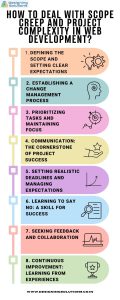Introduction
In the dynamic world of web development, the fear of missing out (FOMO) is a prevalent concern among developers. With new technologies and frameworks emerging at an unprecedented pace, it’s easy to feel overwhelmed and like you’re constantly chasing the latest trends. The rapid pace of innovation, while exciting, can also be daunting, leaving many developers struggling to keep up with the ever-evolving tech landscape.
The fear of falling behind can lead to anxiety, self-doubt, and even hinder your growth as a developer. However, it’s crucial to remember that you’re not alone in this feeling. Numerous web developers experience FOMO, especially in the early stages of their careers.
The key to overcoming FOMO lies in adopting a mindset of continuous learning and embracing the ever-changing nature of technology. By implementing effective strategies, you can navigate the tech landscape with confidence and unleash your full potential as a web developer.

1. Focus on the Fundamentals: A Solid Foundation for Growth
While staying updated on the latest trends is important, don’t neglect the fundamentals of web development. A strong foundation in core concepts like HTML, CSS, and JavaScript will serve you well, regardless of the latest frameworks or libraries that emerge. These fundamental building blocks will provide you with a solid understanding of how web development works, enabling you to adapt to new technologies more effectively.
2. Cultivate Continuous Learning: A Habit for Lifelong Growth
Continuous learning is an essential aspect of being a successful web developer. Make learning a habit by setting aside dedicated time each week to explore new technologies, read blog posts, watch tutorials, or attend online workshops. Dedicate yourself to expanding your knowledge base, staying curious, and embracing new challenges.
3. Identify Your Niche: Specialization for Deeper Expertise
Instead of trying to master everything, find a specific area of web development that piques your interest and focus on deepening your expertise in that area. This could be front-end development, back-end development, full-stack development, or a specific technology like React or Angular. By specializing in a particular niche, you can become an expert in your chosen field, gaining a deeper understanding of its intricacies and gaining recognition as a valuable asset.
4. Engage with the Community: Sharing Knowledge and Gaining Insights
Join online forums, attend local meetups, and connect with other developers. Sharing knowledge and experiences with others is a powerful way to stay updated on trends, learn new techniques, and gain valuable insights from fellow developers. Engage in discussions, ask questions, and actively participate in the community to strengthen your network and gain a broader perspective on the industry.
5. Embrace the Ever-Changing Nature of Tech: Adaptability in a Dynamic Environment
Instead of fearing change, embrace it as an opportunity for growth. New technologies often bring new opportunities to solve problems more efficiently, create better user experiences, and expand your skillset. View change as a catalyst for continuous learning and improvement, allowing you to stay at the forefront of the industry.
6. Focus on Your Growth, Not Perfection: Celebrating Progress and Learning
Remember that continuous learning is a journey, not a destination. Don’t strive for perfection; instead, focus on consistent growth, improvement, and celebrating your progress along the way. Acknowledge your achievements, no matter how small, as they represent steps forward in your development journey.
7. Prioritize Your Mental Health: A Vital Aspect of Well-being
Navigating the tech landscape can be mentally demanding. Set boundaries, take breaks, and prioritize your well-being. Remember that your mental health is just as important as your technical skills. Implement stress-management techniques, engage in activities that bring you joy, and maintain a healthy work-life balance to ensure your overall well-being.
8. Seek Help When Needed: Embracing Support and Guidance
Don’t hesitate to reach out to mentors, colleagues, or online communities when you need help or guidance. There’s no shame in asking for assistance; it’s a sign of growth and willingness to learn. Seek support from experienced developers, mentors, or online forums when you encounter challenges or need clarification on specific concepts.
9. Enjoy the Journey: Finding Fulfillment in Continuous Learning and Growth
Web development is an exciting and rewarding field. Embrace the challenges, celebrate your accomplishments, and find fulfillment in the process of continuous learning and growth. Approach your work with enthusiasm, curiosity, and a willingness to learn, and you will discover the immense satisfaction that comes from mastering this ever-evolving field.






